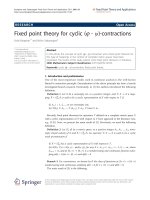Báo cáo toán học: " Fixed point theorems for contraction mappings in modular metric spaces" pptx
Bạn đang xem bản rút gọn của tài liệu. Xem và tải ngay bản đầy đủ của tài liệu tại đây (216.37 KB, 21 trang )
This Provisional PDF corresponds to the article as it appeared upon acceptance. Fully formatted
PDF and full text (HTML) versions will be made available soon.
Fixed point theorems for contraction mappings in modular metric spaces
Fixed Point Theory and Applications 2011, 2011:93 doi:10.1186/1687-1812-2011-93
Chirasak Mongkolkeha ()
Wultiphol Sintunavarat ()
Poom Kumam ()
ISSN 1687-1812
Article type Research
Submission date 20 June 2011
Acceptance date 2 December 2011
Publication date 2 December 2011
Article URL />This peer-reviewed article was published immediately upon acceptance. It can be downloaded,
printed and distributed freely for any purposes (see copyright notice below).
For information about publishing your research in Fixed Point Theory and Applications go to
/>For information about other SpringerOpen publications go to
Fixed Point Theory and
Applications
© 2011 Mongkolkeha et al. ; licensee Springer.
This is an open access article distributed under the terms of the Creative Commons Attribution License ( />which permits unrestricted use, distribution, and reproduction in any medium, provided the original work is properly cited.
Fixed point theorems for contraction
mappings in modular metric spaces
Chirasak Mongkolkeha, Wutiphol Sintunavarat and Poom Kumam
∗
Department of Mathematics, Faculty of Science,
King Mongkut’s University of Technology Thonburi
(KMUTT), Bangmod, Bangkok 10140, Thailand
∗
Corresponding author:
Email addresses:
CM:
WS: poom
Abstract
In this article, we study and prove the new existence theorems of fixed
points for contraction mappings in modular metric spaces.
AMS: 47H09; 47H10.
Keywords: modular metric spaces; modular spaces; contraction map-
pings; fixed points.
1
2
1 Introduction
Let (X, d) be a metric space. A mapping T : X → X is a contraction if
d(T (x), T (y)) ≤ kd(x, y), (1.1)
for all x, y ∈ X, where 0 ≤ k < 1. The Banach Contraction Mapping Princi-
ple appeared in explicit form in Banach’s thesis in 1922 [1]. Since its simplicity
and usefulness, it has become a very popular tool in solving existence problems
in many branches of mathematical analysis. Banach contraction principle has
been extended in many different directions, see [2–10]. The notion of modular
spaces, as a generalize of metric spaces, was introduced by Nakano [11] and was
intensively developed by Koshi, Shimogaki, Yamamuro [11–13] and others. Fur-
ther and the most complete development of these theories are due to Luxemburg,
Musielak, Orlicz, Mazur, Turpin [14–18] and their collaborators. A lot of math-
ematicians are interested fixed points of Modular spaces, for example [4, 19–26].
In 2008, Chistyakov [27] intro duced the notion of modular metric spaces
generated by F -modular and develop the theory of this spaces, on the same idea
he was defined the notion of a modular on an arbitrary set and develop the the-
ory of metric spaces generated by modular such that called the modular metric
spaces in 2010 [28].
In this article, we study and prove the existence of fixed point theorems
for contraction mappings in modular metric spaces.
3
2 Preliminaries
We will start with a brief recollection of basic concepts and facts in modular
spaces and modular metric spaces (see [14,15, 27–29] for more details).
Definition 2.1. Let X be a vector space over R(or C). A functional ρ : X →
[0, ∞] is called a modular if for arbitrary x and y, elements of X satisfies the
following three conditions :
(A.1) ρ(x) = 0 if and only if x = 0;
(A.2) ρ(αx) = ρ(x) for all scalar α with |α| = 1;
(A.3) ρ(αx + βy) ≤ ρ(x) + ρ(y), whenever α, β ≥ 0 and α + β = 1.
If we replace (A.3) by
(A.4) ρ(αx + βy) ≤ α
s
ρ(x) + β
s
ρ(y), for α, β ≥ 0, α
s
+ β
s
= 1 with an s ∈ (0, 1],
then the modular ρ is called s-convex modular, and if s = 1, ρ is called a
convex modular.
If ρ is modular in X, then the set defined by
X
ρ
= {x ∈ X : ρ(λx) → 0 as λ → 0
+
}
(2.1)
is called a modular space. X
ρ
is a vector subspace of X it can be equipped with
an F -norm defined by setting
x
ρ
= inf{λ > 0 : ρ(
x
λ
) ≤ λ}, x ∈ X
ρ
.
(2.2)
4
In addition, if ρ is convex, then the modular space X
ρ
coincides with
X
∗
ρ
= {x ∈ X : ∃λ = λ(x) > 0 such that ρ(λx) < ∞}
(2.3)
and the functional x
∗
ρ
= inf{λ > 0 : ρ(
x
λ
) ≤ 1} is an ordinary norm on X
∗
ρ
which is equivalence to x
ρ
(see [16]).
Let X be a nonempty set, λ ∈ (0, ∞) and due to the disparity of the
arguments, function w : (0, ∞) × X × X → [0, ∞] will be written as w
λ
(x, y) =
w(λ, x, y) for all λ > 0 and x, y ∈ X.
Definition 2.2. [28, Definition 2.1] Let X be a nonempty set. A function
w : (0, ∞) × X × X → [0, ∞] is said to be a metric modular on X if satisfying,
for all x, y, z ∈ X the following condition holds:
(i) w
λ
(x, y) = 0 for all λ > 0 if and only if x = y;
(ii) w
λ
(x, y) = w
λ
(y, x) for all λ > 0;
(iii) w
λ+µ
(x, y) ≤ w
λ
(x, z) + w
µ
(z, y) for all λ, µ > 0.
If instead of (i), we have only the condition
(i
) w
λ
(x, x) = 0 for all λ > 0, then w is said to be a (metric)pseudomodular
on X.
The main property of a (pseudo)modular w on a set X is a following: given
x, y ∈ X, the function 0 < λ → w
λ
(x, y) ∈ [0, ∞] is a nonincreasing on (0, ∞).
5
In fact, if 0 < µ < λ, then (iii), (i
) and (ii) imply
w
λ
(x, y) ≤ w
λ−µ
(x, x) + w
µ
(x, y) = w
µ
(x, y).
(2.4)
It follows that at each point λ > 0 the right limit w
λ+0
(x, y) := lim
→+0
w
λ+
(x, y)
and the left limit w
λ−0
(x, y) := lim
ε→+0
w
λ−ε
(x, y) exists in [0, ∞] and the following
two inequalities hold :
w
λ+0
(x, y) ≤ w
λ
(x, y) ≤ w
λ−0
(x, y).
(2.5)
Definition 2.3. [28, Definition 3.3] A function w : (0, ∞) × X × X → [0, ∞]
is said to be a convex(metric)modular on X if it is satisfies the conditions (i) and
(ii) from Definition 2.2 as well as this condition holds;
(iv) w
λ+µ
(x, y) =
λ
λ+µ
w
λ
(x, z) +
µ
λ+µ
w
µ
(z, y) for all λ, µ > 0 and x, y, z ∈ X.
If instead of (i), we have only the condition (i
) from Definition 2.2, then w is
called a convex(metric) pseudomodular on X.
From [27,28], we know that, if x
0
∈ X, the set X
w
= {x ∈ X : lim
λ→∞
w
λ
(x, x
0
) =
0} is a metric space, called a modular space, whose metric is given by d
◦
w
(x, y) =
inf{λ > 0 : w
λ
(x, y) ≤ λ} for all x, y ∈ X
w
. Moreover, if w is convex, the modular
set X
w
is equal to X
∗
w
= {x ∈ X : ∃λ = λ(x) > 0 such that w
λ
(x, x
0
) < ∞} and
metrizable by d
∗
w
(x, y) = inf{λ > 0 : w
λ
(x, y) ≤ 1} for all x, y ∈ X
∗
w
. We know
that (see [28, Theorem 3.11]) if X is a real linear space, ρ : X → [0, ∞] and
w
λ
(x, y) = ρ
x − y
λ
for all λ > 0 and x, y ∈ X, (2.6)
6
then ρ is modular (convex modular) on X in the sense of (A.1)–(A.4) if and only
if w is metric modular(convex metric modular, respectively) on X. On the other
hand, if w satisfy the following two conditions (i) w
λ
(µx, 0) = w
λ/µ
(x, 0) for all
λ, µ > 0 and x ∈ X, (ii) w
λ
(x + z, y + z) = w
λ
(x, y) for all λ > 0 and x, y, z ∈ X,
if we set ρ(x) = w
1
(x, 0) with (2.6) holds, where x ∈ X, then
(i) X
ρ
= X
w
is a linear subspace of X and the functional x
ρ
= d
◦
w
(x, 0),
x ∈ X
ρ
, is an F-norm on X
ρ
;
(ii) if w is convex, X
∗
ρ
≡ X
∗
w
(0) = X
ρ
is a linear subspace of X and the func-
tional x
ρ
= d
∗
w
(x, 0), x ∈ X
∗
ρ
, is an norm on X
∗
ρ
.
Similar assertions hold if replace the word modular by pseudomodular. If w
is metric modular in X, we called the set X
w
is modular metric space.
By the idea of property in metric spaces and modular spaces, we defined the
following:
Definition 2.4. Let X
w
be a modular metric space.
(1) The sequence (x
n
)
n∈N
in X
w
is said to be convergent to x ∈ X
w
if w
λ
(x
n
, x) → 0, as n → ∞ for all λ > 0.
(2) The sequence (x
n
)
n∈N
in X
w
is said to be Cauchy if w
λ
(x
m
, x
n
) → 0, as
m, n → ∞ for al l λ > 0.
(3) A subset C of X
w
is said to be closed if the limit of a convergent sequence
of C always belong to C.
7
(4) A subset C of X
w
is said to be complete if any Cauchy sequence in C is
convergent sequence and its is in C.
(5) A subset C of X
w
is said to be bounded if for all λ > 0
δ
w
(C) = sup{w
λ
(x, y); x, y ∈ C} < ∞.
3 Main results
In this section, we prove the existence of fixed points theorems for con-
traction mapping in modular metric spaces.
Definition 3.1. Let w be a metric modular on X and X
w
be a modular metric
space induced by w and T : X
w
→ X
w
be an arbitrary mapping. A mapping T is
called a contraction if for each x, y ∈ X
w
and for all λ > 0 there exists 0 ≤ k < 1
such that
w
λ
(T x, T y) ≤ kw
λ
(x, y). (3.1)
Theorem 3.2. Let w be a metric modular on X and X
w
be a modular metric
space induced by w. If X
w
is a complete modular metric space and T : X
w
→ X
w
is a contraction mapping, then T has a unique fixed point in X
w
. Moreover, for
any x ∈ X
w
, iterative sequence {T
n
x} converges to the fixed point.
Proof. Let x
0
ba an arbitrary point in X
w
and we write x
1
= T x
0
, x
2
= T x
1
=
T
2
x
0
, and in general, x
n
= T x
n−1
= T
n
x
0
for all n ∈ N. Then,
8
w
λ
(x
n+1
, x
n
) = w
λ
(T x
n
, T x
n−1
)
≤ kw
λ
(x
n
, x
n−1
)
= kw
λ
(T x
n−1
, T x
n−2
)
≤ k
2
w
λ
(x
n−1
, x
n−2
)
.
.
.
≤ k
n
w
λ
(x
1
, x
0
)
for all λ > 0 and for each n ∈ N. If m > n, by Definition 2.2(iii), implies
w
λ
(x
n
, x
m
) = w
λ·(m−n)
m−n
(x
n
, x
m
)
≤ w
λ
m−n
(x
n
, x
n+1
) + w
λ
m−n
(x
n+1
, x
n+2
) + · · · + w
λ
m−n
(x
m−1
, x
m
)
≤ k
n
w
λ
m−n
(x
0
, x
1
) + k
n+1
w
λ
m−n
(x
0
, x
1
) + · · · + k
m−1
w
λ
m−n
(x
0
, x
1
)
= (k
n
+ k
n+1
+ · · · + k
m−1
)w
λ
m−n
(x
0
, x
1
)
≤ (
k
n
1−k
)w
λ
m−n
(x
0
, x
1
).
(3.2)
Taking n, m → ∞ in (3.2), we have w
λ
(x
n
, x
m
) → 0. Thus, {x
n
} is a Cauchy
sequence and by the completeness of X
w
there exists a point x ∈ X
w
such that
x
n
→ x as n → ∞. By the notion of metric modular w and the contraction of T ,
we get
w
λ
(T x, x) ≤ w
λ
2
(T x, T x
n
) + w
λ
2
(T x
n
, x)
≤ kw
λ
2
(x, x
n
) + w
λ
2
(x
n+1
, x)
(3.3)
for all λ > 0 and for each n ∈ N. Taking n → ∞ in (3.3) implies that w
λ
(T x, x) =
0 for all λ > 0 and thus T x = x. Hence, x is a fixed point of T . Next, we prove
that x is a unique fixed point. Suppose that z is another fixed point of T . We
9
see that
w
λ
(x, z) = w
λ
(T x, T z)
≤ kw
λ
(x, z)
for all λ > 0. Since 0 ≤ k < 1, we get w
λ
(x, z) = 0 for all λ > 0 this implies that
x = z . Therefore, x is a unique fixed point of T and the proof is complete.
Theorem 3.3. Let w be a metric modular on X and X
w
be a modular metric
space induced by w. If X
w
is a complete modular metric space and T : X
w
→ X
w
is a contraction mapping. Suppose x
0
∈ X
w
is a fixed point of T, {ε
n
} is a
sequence of positive numbers for which lim
n→∞
ε
n
= 0, and {y
n
} ⊆ X
w
satisfies
w
λ
(y
n+1
, T y
n
) ≤ ε
n
for all λ > 0. Then, lim
n→∞
y
n
= x
0
.
Proof. For each m ∈ N, we observe that
w
λ
(T
m+1
x, y
m+1
) = w
λ·m
m
(T
m+1
x, y
m+1
)
≤ w
λ·(m−1)
m
(T
m+1
x, T y
m
) + w
λ
m
(T y
m
, y
m+1
)
≤ kw
λ·(m−1)
m
(T
m
x, y
m
) + ε
m
≤ kw
λ·(m−2)
m
(T
m
x, T y
m−1
) + kw
λ
m
(T y
m−1
x, y
m
) + ε
m
≤ k
2
w
λ·(m−2)
m
(T
m−1
x, y
m−1
) + kε
m−1
+ ε
m
.
.
.
≤
m
i=0
k
m−i
ε
i
(3.4)
10
for all λ > 0. Thus, we get
w
λ
(y
m+1
, x
0
) ≤ w
λ
2
(y
m+1
, T
m+1
x) + w
λ
2
(T
m+1
x, x
0
)
≤
m
i=0
k
m−i
ε
i
+ w
λ
2
(T
m+1
x, x
0
).
(3.5)
Next, we claimed that lim
m→∞
w
λ
(y
m+1
, x
0
) = 0 for all λ > 0.
Now let ε > 0. Since lim
n→∞
ε
n
= 0, there exists N ∈ N such that for m ≥ N ,
ε
m
≤ ε. Thus,
m
i=0
k
m−i
ε
i
=
N
i=0
k
m−i
ε
i
+
m
i=N+1
k
m−i
ε
i
≤ k
m−N
N
i=0
k
N−i
ε
i
+ ε
m
i=N+1
k
m−i
.
(3.6)
Taking limit as m → ∞ in (3.6), we have
lim
m→∞
m
i=0
k
m−i
ε
i
= 0. (3.7)
Since x
0
is a fixed point of T and using result of Theorem 3.2, we get the sequence
{T
n
x} converge to x
0
. This implies that
lim
m→∞
w
λ
2
(T
m+1
x, x
0
) = 0 (3.8)
for all λ > 0. From (3.5), (3.7) and (3.8), we have
lim
m→∞
w
λ
(y
m+1
, x
0
) = 0 (3.9)
for all λ > 0 which implies that lim
n→∞
y
n
= x
0
.
Theorem 3.4. Let w be a metric modular on X and X
w
be a modular metric
space induced by w. If X
w
is a complete modular metric space and T : X
w
→ X
w
is a mapping, which T
N
is a contraction mapping for some positive integer N.
Then, T has a unique fixed point in X
w
.
11
Proof. By Theorem 3.2, T
N
has a unique fixed point u ∈ X
w
. From T
N
(T u) =
T
N+1
u = T(T
N
u) = Tu, so T u is a fixed point of T
N
. By the uniqueness of fixed
point of T
N
, we have Tu = u. Thus, u is a fixed point of T . Since fixed point of
T is also fixed point of T
N
, we can conclude that T has a unique fixed point in
X
w
.
Theorem 3.5. Let w be metric modular on X, X
w
be a complete modular
metric space induced by w and for x
0
∈ X
w
we define
B
w
(x
0
, γ) := {x ∈ X
w
|w
λ
(x, x
0
) ≤ γ forall λ > 0}.
If T : B
w
(x
0
, γ) → X
w
is a contraction mapping with
w
λ
2
(T x
0
, x
0
) ≤ (1 − k)γ
(3.10)
for all λ > 0, where 0 ≤ k < 1. Then, T has a unique fixed point in B
w
(x
0
, γ).
Proof. By Theorem 3.2, we only prove that B
w
(x
0
, γ) is complete and T x ∈
B
w
(x
0
, γ), for all x ∈ B
w
(x
0
, γ). Suppose that {x
n
} is a Cauchy sequence in
B
w
(x
0
, γ), also {x
n
} is a Cauchy sequence in X
w
. Since X
w
is complete, there
exists x ∈ X
w
such that
lim
n→∞
w
λ
2
(x
n
, x) = 0
(3.11)
for all λ > 0. Since for each n ∈ N, x
n
∈ B
w
(x
0
, γ), using the property of metric
modular, we get
w
λ
(x
0
, x) ≤ w
λ
2
(x
0
, x
n
) + w
λ
2
(x
n
, x
0
)
≤ γ + w
λ
2
(x
n
, x
0
)
(3.12)
12
for all λ > 0. It follows the inequalities (3.11) and (3.12), we have w
λ
(x
0
, x) ≤ γ
which implies that x ∈ B
w
(x
0
, γ). Therefore, {x
n
} is convergent sequence in
B
w
(x
0
, γ) and also B
w
(x
0
, γ) is complete.
Next, we prove that T x ∈ B
w
(x
0
, γ) for all x ∈ B
w
(x
0
, γ). Let x ∈
B
w
(x
0
, γ). From the inequalities (3.10), using the contraction of T and the notion
of metric modular, we have
w
λ
(x
0
, T x) ≤ w
λ
2
(x
0
, T x
0
) + w
λ
2
(T x
0
, T x)
≤ (1 − k)γ + kw
λ
2
(x
0
, x)
≤ (1 − k)γ + kγ
= γ.
Therefore, T x ∈ B
w
(x
0
, γ) and the proof is complete.
Theorem 3.6. Let w be a metric modular on X, X
w
be a complete modular
metric space induced by w and T : X
w
→ X
w
. If there exists η ∈ (0, λ) such that
w
λ
(T x, T y) ≤ k(w
λ+η
(T x, x) + w
λ+η
(T y, y))
(3.13)
for all x, y ∈ X
w
and for all λ > 0, where k ∈ [0,
1
2
), then T has a unique fixed
point in X
w
. Moreover, for any x ∈ X
w
, iterative sequence {T
n
x} converges to
the fixed point.
Proof. Let x
0
be an arbitrary point in X
w
and we write x
1
= T x
0
, x
2
= T x
1
=
T
2
x
0
, and in general, x
n
= T x
n−1
= T
n
x
0
for all n ∈ N. If T x
n
0
−1
= T x
n
0
for
some n
0
∈ N, then T x
n
0
= x
n
0
. Thus, x
n
0
is a fixed p oint of T . Suppose that
13
T x
n−1
= T x
n
for all n ∈ N. For k ∈ [0,
1
2
), we have
w
λ
(x
n+1
, x
n
) = w
λ
(T x
n
, T x
n−1
)
≤ k(w
λ+η
(T x
n
, x
n
) + w
λ+η
(T x
n−1
, x
n−1
))
≤ k(w
η
(T x
n
, T x
n
) + w
λ
(T x
n
, x
n
) + w
η
(T x
n−1
, T x
n−1
)
+ w
λ
(T x
n−1
, x
n−1
))
= k(w
λ
(T x
n
, x
n
) + w
λ
(T x
n−1
, x
n−1
))
= k(w
λ
(x
n+1
, x
n
) + w
λ
(x
n
, x
n−1
))
(3.14)
for all λ > 0 and for all n ∈ N. Hence,
w
λ
(x
n+1
, x
n
) ≤
k
1−k
w
λ
(x
n
, x
n−1
)
(3.15)
for all λ > 0 and for all n ∈ N. Put β :=
k
1−k
, since k ∈ (0,
1
2
), we get β ∈ (0 , 1)
and hence
w
λ
(x
n+1
, x
n
) ≤ βw
λ
(x
n
, x
n−1
)
≤ β
2
w
λ
(x
n−1
, x
n−2
)
.
.
.
≤ β
n
w
λ
(x
1
, x
0
)
(3.16)
for all λ > 0 and for all n ∈ N. If m > n, we have
w
λ
(x
m
, x
n
) ≤ w
λ(
m−n
m−n
)
(x
m
, x
n
)
≤ w
λ
m−n
(x
m
, x
m−1
) + w
λ
m−n
(x
m−1
, x
m−2
) + · · · + w
λ
m−n
(x
n+1
, x
n
)
≤ β
m−1
w
λ
m−n
(x
1
, x
0
) + β
m−2
w
λ
m−n
(x
1
, x
0
) + · · · + β
n
w
λ
m−n
(x
1
, x
0
)
= (β
m−1
+ β
m−2
+ · · · + β
n
)w
λ
m−n
(x
1
, x
0
)
≤
β
n
1−β
w
λ
m−n
(x
1
, x
0
)
(3.17)
14
for all λ > 0. Taking m, n → ∞ in the inequality (3.17), we get {x
n
} is a Cauchy
sequence and by the completeness of X
w
there exists a point x ∈ X
w
such that
x
n
→ x as n → ∞. By the property of metric modular and the inequality (3.13),
we have
w
λ
(T x, x) ≤ w
λ−η+η
(T x, x)
≤ w
λ−η
(T x, T x
n
) + w
η
(T x
n
, x)
≤ k(w
λ
(T x, x) + w
λ
(T x
n
, x
n
)) + w
η
(T x
n
, x)
≤ k(w
λ
(T x, x) + w
λ
2
(T x
n
, x) + w
λ
2
(x, x
n
)) + w
η
(T x
n
, x)
= k(w
λ
(T x, x) + w
λ
2
(x
n+1
, x) + w
λ
2
(x, x
n
)) + w
η
(x
n+1
, x)
(3.18)
for all λ > 0 and for all n ∈ N. Taking n → ∞ in the inequality (3.18), we
obtained that
w
λ
(T x, x) ≤ kw
λ
(T x, x).
(3.19)
Since k ∈ [0,
1
2
), we have T x = x. Thus, x is a fixed point of T . Next, we prove
that x is a unique fixed point. Suppose that z be another fixed point of T. We
note that
w
λ
(x, z) = w
λ
(T x, T z)
≤ k(w
λ+η
(T x, x) + w
λ+η
(T z, z))
= 0
for all λ > 0, which implies that x = z. Therefore, x is a unique fixed point of
T .
Now, we shall give the example to validate Theorem 3.2.
15
Example 3.7. Let X = {(a, 0) ∈ R
2
|0 ≤ a ≤ 1} ∪ {(0, b) ∈ R
2
|0 ≤ b ≤ 1}.
Defined the mapping w : (0, ∞) × X × X → [0, ∞] by
w
λ
((a
1
, 0), (a
2
, 0)) =
4|a
1
− a
2
|
3λ
,
w
λ
((0, b
1
), (0, b
2
)) =
|b
1
− b
2
|
λ
,
and
w
λ
((a, 0), (0, b)) =
4a
3λ
+
b
λ
= w
λ
((0, b), (a, 0)).
We note that if we take λ → ∞, then we see that X = X
w
and also X
w
is a
complete modular metric space. We let a mapping T : X
w
→ X
w
is define by
T ((a, 0)) = (0, a)
and
T ((0, b)) =
b
2
, 0
.
Simple computations show that
w
λ
(T ((a
1
, b
1
)), T ((a
2
, b
2
))) ≤
3
4
w
λ
((a
1
, b
1
), (a
2
, b
2
))
for all (a
1
, b
1
), (a
2
, b
2
) ∈ X
w
. Thus, T is a contraction mapping with constant
k =
3
4
. Therefore, T has a unique fixed point that is (0, 0) ∈ X
w
.
On the Euclidean metric d on X
w
, we see that
d(T ((0, 0)), T ((1, 0))) = d((0, 0), (0, 1)) = 1 > k = kd((0, 0), (1, 0))
for all k ∈ [0, 1). Thus, T is not a contraction mapping and then the Banach
contraction mapping cannot be applied to this example.
16
Competing interests
The authors declare that they have no competing interests.
Authors’ contributions
All authors read and approved the final manuscript.
Acknowledgments
The authors thank the referee for comments and suggestions on this manu-
script. The first author was supported by the Thailand Research Fund through
the Royal Golden Jubilee Ph.D. Program (Grant No. PHD/ 0029/2553). The
second author would like to thank the Research Professional Development Project
Under the Science Achievement Scholarship of Thailand (SAST) and the Faculty
of Science, KMUTT for financial support during the preparation of this manu-
script for the Ph.D. Program. The third author was supported by the Commission
on Higher Education and the Thailand Research Fund (Grant No.MRG5380044).
Moreover, this study was supported by the Higher Education Research Promo-
tion and National Research University Project of Thailand, Office of the Higher
Education Commission (under NRU-CSEC Project No. 54000267).
17
References
[1] Banach, S: Sur les op´erations dans les ensembles abstraits et leurs applica-
tions aux ´equations int´egrales. Fund. Math. 3, 133–181 (1922)
[2] Jungck, G: Compatible mappings and common fixed points. Int. J. Math.
Math. Sci. 9, 771–779 (1986)
[3] Jungck, G, Rhoades, BE: Fixed points for set valued functions without con-
tinuity. Indian J. Pure Appl. Math. 29, 227–238 (1998)
[4] Razani, A, Nabizadeh, E, Beyg Mohamadi, M, Homaeipour, S: Fixed point
of nonlinear and asymptotic contractions in the modular space. Abstr. Appl.
Anal. 2007, Article ID 40575, 10 (2007)
[5] Rhoades, BE: Some theorems on weakly contractive maps. Nonlinear Anal.
47, 2683–2693 (2001)
[6] Sintunavart, W, Kumam, P: Coincidence and common fixed points for hybrid
strict contractions without the weakly commuting condition. Appl. Math.
Lett. 22, 1877–1881 (2009)
[7] Sintunavart, W, Kumam, P: Weak condition for generalized multi-valued
(f, α, β)-weak contraction mappings. Appl. Math. Lett. 24, 460–465 (2011)
18
[8] Sintunavart, W, Kumam, P: Gregus type fixed points for a tangential multi-
valued mappings satisfying contractive conditions of integral type. J. Inequal.
Appl. 2011, 3 (2011)
[9] Sintunavarat, W, Cho, YJ, Kumam, P: Common fixed point theorems for c-
distance in ordered cone metric spaces. Comput. Math. Appl. 62, 1969–1978
(2011)
[10] Sintunavart, W, Kumam, P: Common fixed point theorems for generalized
J H -operator classes and invariant approximations. J. Inequal. Appl. 2011,
67 (2011)
[11] Nakano, H: Modulared Semi-Ordered Linear Spaces. Tokyo Math. Book Ser.,
vol. 1. Maruzen Co., Tokyo (1950)
[12] Koshi, S, Shimogaki, T: On F-norms of quasi-modular spaces. J. Fac. Sci.
Hokkaido Univ. Ser. I. 15(3–4), 202–218 (1961)
[13] Yamamuro, S: On conjugate spaces of Nakano spaces. Trans. Amer. Math.
Soc. 90, 291–311 (1959)
[14] Luxemburg, WAJ: Banach function spaces. Thesis, Delft, Inst. of Techn.
Assen, The Netherlands (1955)
[15] Mosielak, J, Orlicz, W: On modular spaces. Studia Math. 18, 49–65 (1959)
19
[16] Musielak, J, Orlicz, W: Some remarks on modular spaces. Bull. Acad. Polon.
Sci. Sr. Sci. Math. Astron. Phys. 7, 661–668 (1959)
[17] Mazur, S, Orlicz, W: On some classes of linear spaces. Studia Math. 17,
97–119. Reprinted in [21]: 981–1003 (1958)
[18] Turpin, Ph: Fubini inequalities and bounded multiplier property in general-
ized modular spaces. Comment. Math. Tomus specialis in honorem Ladislai
Orlicz I 331–353 (1978)
[19] Beygmohammadi M, Razani, A: Two fixed point theorems for mappings
satisfying a general contractive condition of integral type in the modular
spaces. Int. J. Math. Math. Sci. 2010, Article ID 317107, 10 (2010)
[20] Dominguez-Benavides, T, Khamsi, MA, Samadi, S: Uniformly Lipschitzian
mappings in modular function spaces. Nonlinear Anal. Theory Methods
Appl. 46, 267–278 (2001)
[21] Khamsi, MA: Quasicontraction mappings in modular spaces without ∆
2
-
condition. Fixed Point Theory Appl. 2008 , Article ID 916187, 6 (2008)
[22] Khamsi, MA, Kozlowski, WM, Reich, S: Fixed point theory in modular
function spaces. Nonlinear Anal. Theory Metho ds Appl. 14, 935–953 (1990)
[23] Kuaket, K, Kumam, P: Fixed point for asymptotic pointwise contractions
in modular spaces. Appl. Math. Lett. 24, 1795–1798 (2011)
20
[24] Kumam, P: On uniform opial condition, uniform Kadec–Klee property in
modular spaces and application to fixed point theory. J. Interdisciplinary
Math. 8, 377–385 (2005)
[25] Kumam, P: Fixed point theorems for nonexpansive mapping in modular
spaces. Arch. Math. 40, 345–353 (2004)
[26] Mongkolkeha, C, Kumam, P: Fixed point and common fixed point theo-
rems for generalized weak contraction mappings of integral type in modular
spaces. Int. J. Math. Math. Sci. 2011, Article ID 705943, 12 (2011)
[27] Chistyakov, VV: Modular metric spaces generated by F -modulars. Folia
Math. 14, 3–25 (2008)
[28] Chistyakov, VV: Modular metric spaces I basic concepts. Nonlinear Anal.
72, 1–14 (2010)
[29] Chistyakov, VV: Metric modulars and their application. Dokl. Math. 73(1),
32–35 (2006)









